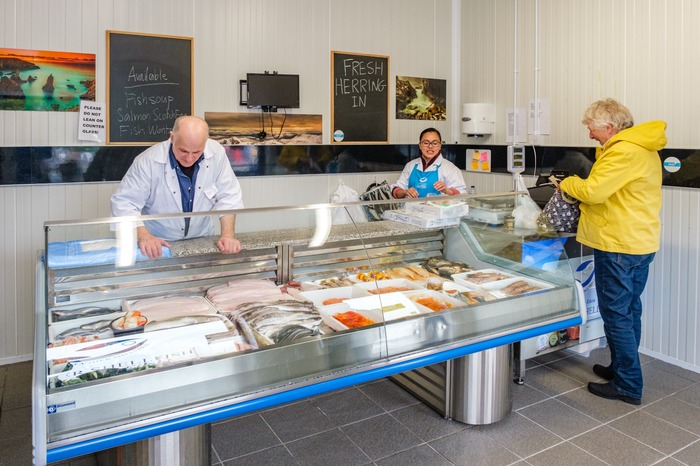Seafood has been a key staple in the diets of people across Britain for centuries, with species originating from British waters, such as Scottish salmon, scallops, mussels and langoustines, becoming renowned for their quality globally.
However, like many other sectors, the seafood market across the UK has been hit hard by inflation and a resultant decline in volume sales. Despite this, frozen fish sales have shown resilience to the ongoing economic challenges, while brands have seen an uptake in fresh fish sales as consumers look to quality products when choosing a seafood dish.
But, research gathered by The Knowledge Bank, the market insight service for the Scottish food and drink sector, shows there are also opportunities for brands to grow the retail market further.
Younger consumers are less likely to be buying seafood products but are also more health-conscious, with a desire to eat high protein and low-calorie foods – something that seafood offers in abundance. The research shows that targeting this sector with inspirational recipes and new convenience products could turn the tide for the market.
Carol Saunders, Head of Insights at The Knowledge Bank, said: “Our research indicates that, while the seafood market has been suffering from the effects of inflation, there are positive signs it remains resilient despite the challenges.
“Affordable alternatives have come to the fore, while discounters and brands have seen successes in certain markets.
“The challenge for companies now is to engage with the younger demographic, capitalising on snacking culture to develop new seafood products that harness the potential of this growing market.”
Frozen fish sales have proven resilient against the ongoing challenges of inflation. This has been spearheaded by discounters which have seen a 15.6% and 41.7% growth in sales value and volume (in Kg) sales respectively as consumers look to more affordable options.
Cod, pollock and prawns make up more than half of these sales UK-wide, with pollock’s affordability making it a key growth market for companies. Frozen haddock and scampi remain popular favourites in Scotland, harbouring a greater market share than England and Wales. [i]
Fresh fish sales across Britain are dominated by salmon, which accounts for nearly 50% of all sales[ii]. Provenance plays a key factor with consumers when purchasing salmon, with 75%[iii] of shoppers saying they are more likely to buy salmon labelled as being from Scotland. This is higher than whisky (71%), meaning that salmon remains the food product most synonymous with the country.
However, salmon has proven to be particularly sensitive to the effects of inflation. At £19.64 per kg (+14.1%[iv] increase year on year), fresh salmon remains one of the most expensive fresh fish species in Britain and this has had a negative impact on the volume sold.
James Park, Head of Insights at Salmon Scotland, said: “Scottish salmon is a global success story that is the UK’s top food export and has been voted the ‘best fish in the world’ by globally renowned chefs.
“Salmon also continues to be the domestic market leader accounting for almost 50% of seafood sales. It continues to be the country’s most popular fish, with sales worth five and volumes four times higher than its next nearest species: cod. We’re very proud to be a key part of the quality food and drink offering from Scotland.
“When it comes to awareness of Scotland’s food and drink offer, the quality, taste and provenance of fresh and smoked Scottish salmon made consumers more likely to purchase salmon than any other locally produced food and drink.
“Scottish salmon leads all others when people are asked to rank the benefits of seafood. Higher global food standards and the significant economic and jobs contribution Scottish salmon makes to Scotland particularly noteworthy.
“Customers can enjoy Scottish salmon in the knowledge that we have world-leading sustainability measures in place from egg to plate, producing nutritious food in the most responsible way.”
Inflation has continued to have a significant impact on the entire fresh fish and shellfish market, but there have been positives signs as well. Brands have experienced a healthy uptake in sales (11.8%) and volume (7.9%) across Britain, with this growth being marginally higher in Scotland. The picture is less rosy for shellfish alone, with consumers not only purchasing less but also spending less on products.
However, scallops – which is one of the most expensive fresh shellfish options – have experienced deflation. In Scotland this has resulted in a positive sales growth of 6.4% and a large 27.5% growth in volume sales[vi], albeit from a small base, highlighting the continued desire among consumers to enjoy quality products at affordable prices.
The demand for added value for consumers has been further highlighted by the strong performance of fishcakes. These products make up a relatively small share of the overall market but further emphasise consumer desire for affordable seafood products.
A potential gap in the market has been highlighted by recent successes of meat snacking brands such as jerky, and single-serve or convenience packaging. These products have seen an exponential growth, more than doubling in sales value since 2016 [vii] (£128m to £281.5m). Innovative seafood producers are pursuing similar successes, as these products perform well with younger consumers and impulse buyers while offering the same high protein and low-calorie benefits.
Provenance also plays a key role in buying decisions, as can be seen by the resilience of salmon despite the fact it has been more heavily affected by inflation than other products. The success of scallops in Scotland due to deflation reinforces this, proving that a strong desire to buy seafood products remains with affordability.
Donna Fordyce, CEO of Seafood Scotland, said: “While challenges remain, it is clear there are pockets of opportunity for producers, particularly with younger consumers.
“Indeed, our current campaign to introduce school children to tasty seafood dishes is designed to address this opportunity, inspiring young people and their families to try simple recipes at home.”
Carol Saunders concluded: “The data shows that British consumers still have a strong appetite for seafood. While inflation has undoubtedly had an impact on volume sales, there are signs for positivity as well.
“Innovation will prove key going forward, while harnessing the market potential of younger consumers could be vital in changing attitudes towards seafood products in the future.”











